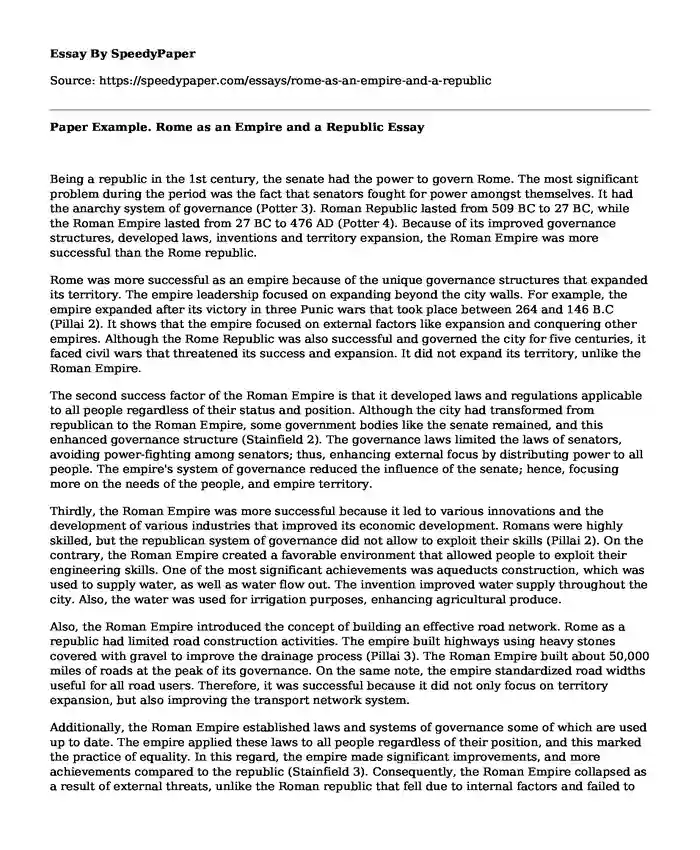
| Type of paper: | Essay |
| Categories: | History Government Sustainable development Roman Empire |
| Pages: | 3 |
| Wordcount: | 648 words |
Being a republic in the 1st century, the senate had the power to govern Rome. The most significant problem during the period was the fact that senators fought for power amongst themselves. It had the anarchy system of governance (Potter 3). Roman Republic lasted from 509 BC to 27 BC, while the Roman Empire lasted from 27 BC to 476 AD (Potter 4). Because of its improved governance structures, developed laws, inventions and territory expansion, the Roman Empire was more successful than the Rome republic.
Rome was more successful as an empire because of the unique governance structures that expanded its territory. The empire leadership focused on expanding beyond the city walls. For example, the empire expanded after its victory in three Punic wars that took place between 264 and 146 B.C (Pillai 2). It shows that the empire focused on external factors like expansion and conquering other empires. Although the Rome Republic was also successful and governed the city for five centuries, it faced civil wars that threatened its success and expansion. It did not expand its territory, unlike the Roman Empire.
The second success factor of the Roman Empire is that it developed laws and regulations applicable to all people regardless of their status and position. Although the city had transformed from republican to the Roman Empire, some government bodies like the senate remained, and this enhanced governance structure (Stainfield 2). The governance laws limited the laws of senators, avoiding power-fighting among senators; thus, enhancing external focus by distributing power to all people. The empire's system of governance reduced the influence of the senate; hence, focusing more on the needs of the people, and empire territory.
Thirdly, the Roman Empire was more successful because it led to various innovations and the development of various industries that improved its economic development. Romans were highly skilled, but the republican system of governance did not allow to exploit their skills (Pillai 2). On the contrary, the Roman Empire created a favorable environment that allowed people to exploit their engineering skills. One of the most significant achievements was aqueducts construction, which was used to supply water, as well as water flow out. The invention improved water supply throughout the city. Also, the water was used for irrigation purposes, enhancing agricultural produce.
Also, the Roman Empire introduced the concept of building an effective road network. Rome as a republic had limited road construction activities. The empire built highways using heavy stones covered with gravel to improve the drainage process (Pillai 3). The Roman Empire built about 50,000 miles of roads at the peak of its governance. On the same note, the empire standardized road widths useful for all road users. Therefore, it was successful because it did not only focus on territory expansion, but also improving the transport network system.
Additionally, the Roman Empire established laws and systems of governance some of which are used up to date. The empire applied these laws to all people regardless of their position, and this marked the practice of equality. In this regard, the empire made significant improvements, and more achievements compared to the republic (Stainfield 3). Consequently, the Roman Empire collapsed as a result of external threats, unlike the Roman republic that fell due to internal factors and failed to adjust to external changes.
Conclusion
Because of its improved governance structures, developed laws, inventions and territory expansion, the Roman Empire was more successful than the Roman republic. The empire focused on equality and expansion of its territory as a response to external changes. It made significant changes in the city like the road network and adequate water supply unlike when it was a republic.
Works Cited
Pillai, Maya. Here are the Greatest Ancient Roman Achievements in History, Feb 17, 2018, https://historyplex.com/ancient-roman-achievements. Accessed 9 December 2019.
Potter, David. The origin of empire: Rome from the Hadrian. New York: Profile Books, 2019. Print.
Stanfield, James. 2018. Rome's Transition from Republic to Empire, July 6, 2018, https://www.nationalgeographic.org/article/romes-transition-republic-empire/. Accessed 9 December 2019.
Cite this page
Paper Example. Rome as an Empire and a Republic. (2023, Mar 14). Retrieved from https://speedypaper.net/essays/rome-as-an-empire-and-a-republic
Request Removal
If you are the original author of this essay and no longer wish to have it published on the SpeedyPaper website, please click below to request its removal:
- Free Essay: Inspiration for Writing Is All Around You
- Free Essay on the Article, Tragedy of the Commons by Garrett Hardin
- Free Essay Example: The Proposed Energy East Pipeline
- End of Life Issues: The Right to Die. Essay Sample.
- Essay Sample on Modern Academic Organization
- Job Description Essay Example: Departmental Manager for the Biotech Company
- Free Essay Dedicated to Interest Groups and The Media
Popular categories




